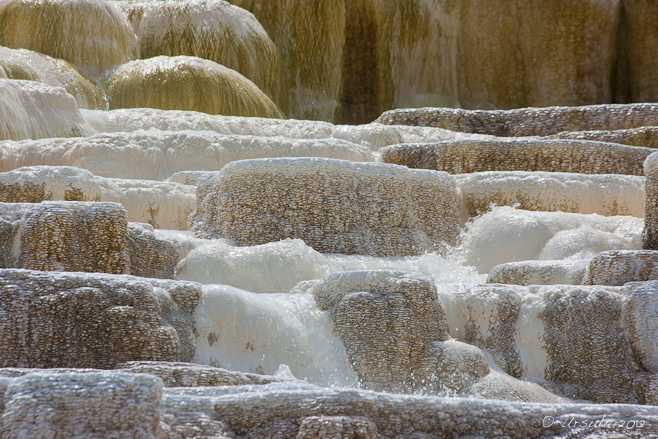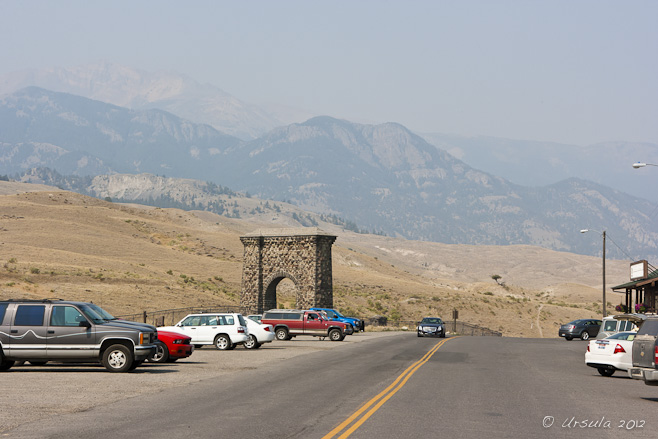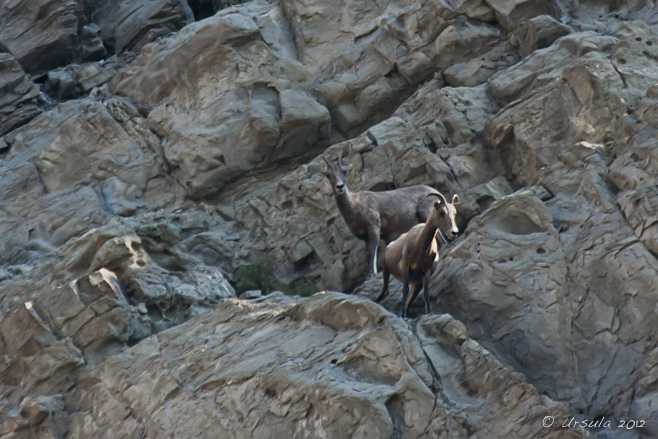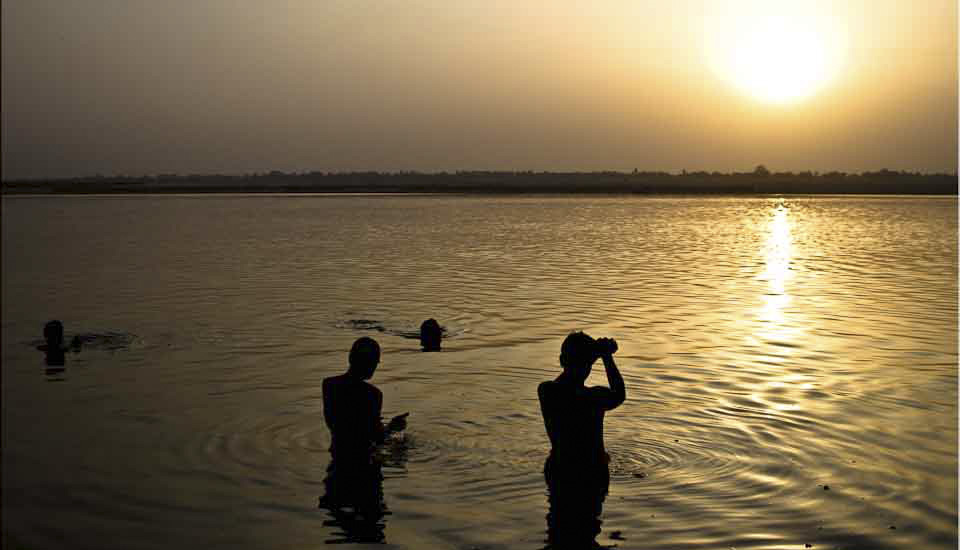
Breathtaking natural beauty: hot spring water splashing over travertine terraces.
Mound Spring at Mammoth Hot Springs, Yellowstone National Park.
It’s pretty hard to beat nature.
And Yellowstone National Park, that amazing natural space covering 8,987 square kilometres (3,472 square miles) of water, grasslands and forest in Western USA, serves up some of nature’s best.
From the iconic spout of Old Faithful to the less visited but equally intriguing Artist’s Paint Pots, Yellowstone’s geothermic features are second to none.
The natural travertine terraces at Mammoth Hot Springs, however, must be the-best-of-the-best.
For our brief visit to Yellowstone Park in August, we stayed at Gardiner, just outside the north entrance to the park. From there it was a short (albeit slow) drive through the Roosevelt Arch to the park’s many attractions.

The North Entrance to Yellowstone is through the rustic town of Gardiner and the Roosevelt Arch, dedicated by (and to) President Theodore Roosevelt in 1903.
Although Yellowstone was established by an act of US Congress in 1872 under President Ulysses S. Grant, the 50-foot tall basalt arch which marks the most important entry into the park was named for President Theodore Roosevelt, conservationist and dedicated Mason, who laid the cornerstone of the structure in 1903.
Once into the park, the landscape changes dramatically. We kept our eyes on the mountains, and were rewarded with sight of a band of Big Horn Sheep: ewes, lambs and yearling males; barely visible as they clambered effortlessly over the rocks. Unfortunately, the older males, with their distinctive, large eponymous horns, were nowhere to be seen.

Almost invisible against the rock face, female and young Big Horn Sheep (Ovis canadensis) on Mount Everts.

Outlined by light, a Big Horn lamb looks to see where mum has gone.
Mammoth Hot Springs are only eight kilometres (5 miles) into the park from the Roosevelt Arch. We circled the busy car park for a while before gaining access to a newly-vacated space, grabbed the cameras and went for a walk along the boardwalks.

Liberty Cap, a 37-foot (11-m) dormant hotspring cone, sits at the northern edge of Mammoth Hot Springs. Built up of mineral deposits over hundreds of years, it was named for its resemblance to the peaked caps worn during the French Revolution.

Flowers on the Edge
Wildflowers grow in the rippled waters of the lower terraces, Mammoth Hot Springs.

Devil’s Thumb, a rocky outcrop, and the travertine layers of Minerva Terrace, Mammoth Hot Springs.
The travertine terraces of Mammoth Hot Springs are like nothing I’d ever seen before. The underlying rock in this area is limestone. Fractures in this limestone allow hot spring waters, replenished by rains and snows, to bubble through to the surface, dissolving calcium carbonate en route and depositing it as travertine.
The result is, as a Yellowstone National Park publication puts it, a “living sculpture”. The shape of Minerva Springs, in particular, changes, dependent on the volume of water, the slope of the ground, and debris in the water’s path. “During some cycles of activity, water discharge and mineral deposition have been so great that boardwalks have been buried beneath mounds of newly deposited travertine.” The colours come from the composition of the travertine itself, and from the particular thermophiles (heat-loving organisms) living in the water.

Hot blue waters and white limestone terraces comprise Minerva Terrace.

Primal Colours: thermophiles (heat-loving organisms) colour different parts of the travertine. Yellow and colourless thermophiles live in the hottest waters; the orange and brown indicate cooler waters.

Lacy white limestone travertine against yellow spring waters, Minerva Terrace

Terraced slopes in white and yellow: Minerva Terrace

Plants on the Edge
Flowers in the hot spring flats – Mammoth Hot Springs.

Hot spring plateau, Mammoth Hot Springs
As beautiful as they are, the terraces, like other geothermal areas, are dangerous. All the pamphlets warn about toxic gasses, and people are entreated to stay on paths and walkways. But, every year, people test the waters with fingers and toes, suffering burns as a consequence. “Over the last decade, 16 park visitors have been burned extensively and deeply enough by geysers or hot springs that they’ve been immediately flown to Salt Lake City for treatment at the University of Utah Hospital regional burn center”(2007).

Up to the Overlook
Elevated walkways protect the sensitive landscape from the tourists – and the tourists from themselves. Every year, people who can’t resist leaving the boardwalks or testing the waters suffer from burns.

Steaming white travertine terraces, with yellow wildflowers at the border. New Blue Spring.

Reflective waters: Main Terrace, Mammoth Springs

Mountains – and mountains of limestone: Main Terrace, Mammoth Springs

Like a waterfall, the hot mineral waters tumble over the terraces of Mound Spring, Mammoth Springs.

Mound Spring

Mound Spring

Twilight, and the wapiti or elk (Cervus canadensis) come out to graze on the lawns around Mammoth Hot Springs.

Mammoth Hot Springs Drive-Bye

Thermal steam in the evening light on the Upper Terraces of Mammoth Hot Springs.

Angel Terrace, on the Upper Terraces of Mammoth Hot Springs.

Trees engulfed by travertine stand like sentinel skeletons against the evening light.
The evening light was falling as we drove around the Upper Terraces, so we pointed the car north for the short trip back to our accommodation.

End of another beautiful day – Yellowstone National Park
Yellowstone –
Truly, a place of beauty.
Photos: 12&14August2012





























.png)


Beautiful trip & adventure
What an amazing planet we live on, you get to see some wonderful things Ursula thanks for sharing them <3
Signe and Gabe – I am always pleased to have your comments! 😀